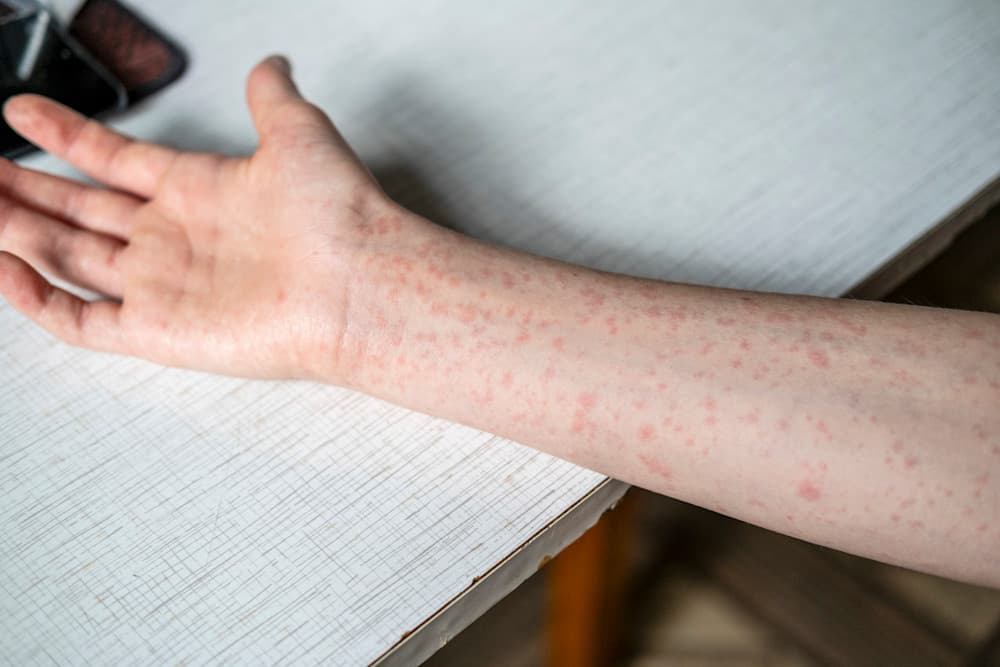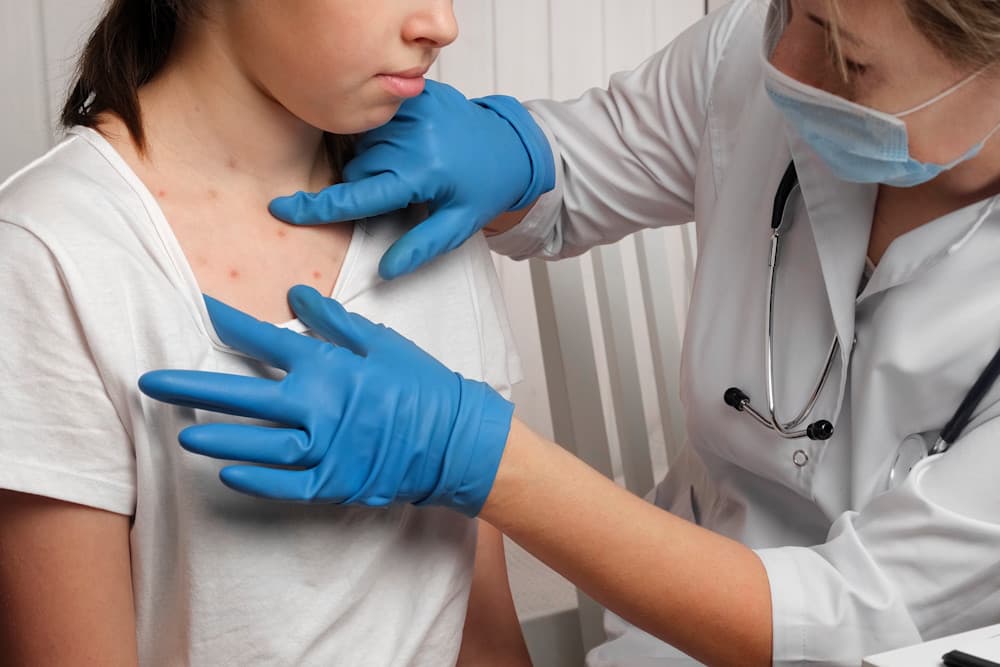Measles is back — Here’s how to stay one step ahead

7 Minutes

Team Curative

Apr 22, 2025
While many assume measles was a disease of the past, recent outbreaks tell a different story. Communities in the United States are facing the resurgence of a disease that spreads quickly and can lead to severe complications. While the headlines are alarming, there’s good news. With the right affordable health insurance and a strong focus on preventive health, you can protect yourself, your family, and your community.
Measles: a brief history
Measles is one of the oldest known diseases, with records tracing back to at least the 9th century. Persian physician Rhazes documented its symptoms in detail, distinguishing it from smallpox. For centuries, measles was a routine part of childhood, often spreading rapidly through communities with devastating effects. Before the measles vaccine was introduced in 1963, nearly 4 million cases occurred annually in the United States alone. Globally, approximately 30 million cases and over 2 million deaths occur each year. That all changed in 1954 when a measles outbreak at a boarding school just outside Boston, Massachusetts, presented a unique opportunity for medical discovery. Doctors at Boston Children’s Hospital collected throat swabs and blood samples from infected students to isolate the virus.
Dr. Thomas Peebles successfully obtained a measles virus culture from an 11-year-old boy named David Edmonston. This pivotal breakthrough allowed researchers to cultivate the virus, setting the stage for vaccine development. The first measles vaccine, based on the Edmonston strain, was introduced in 1963 by Dr. John Enders and his team. By the year 2000, the United States declared measles eliminated as an endemic disease, largely due to widespread vaccination.

Symptoms of measles
However, measles remains a threat. Because of vaccine hesitancy and low vaccination rates in some regions, outbreaks continue to occur. Understanding how measles spreads and how we can prevent it is key to keeping communities safe. Measles is a highly contagious viral infection that mainly affects the respiratory system. According to the Mayo Clinic, symptoms generally appear seven to fourteen days after exposure to the virus.
Measles unfolds in stages, beginning with cold-like symptoms, including fever, cough, runny nose, and inflamed eyes. During stage two, small white spots (called Koplik spots) may appear inside the mouth. After a few days, the characteristic red, blotchy rash spreads across the body, signaling the start of stage three. While many people recover within two to three weeks, complications can occur, particularly in young children, pregnant individuals, and people with weakened immune systems.
How does measles spread?
Measles is incredibly contagious, and the numbers speak volumes. About 90% of unvaccinated individuals will become infected if exposed to someone with the virus through:
Airborne transmission: The virus can linger in the air for up to two hours after an infected person coughs or sneezes.
Surface contact: Touching contaminated surfaces and then touching your face can lead to infection.
Direct contact: Close contact with an infected person is a common transmission route.
A person with measles is contagious from four days before the rash appears to four days after it subsides. That means someone can unknowingly spread the virus before realizing they are sick.
Who is most at risk?
While anyone can contract measles, some groups face a higher risk of severe complications:
Infants under 12 months are too young to receive the vaccine.
Pregnant individuals can experience complications like miscarriage or premature birth.
Immunocompromised people’s bodies cannot effectively fight off the virus.
Unvaccinated people who have not received the MMR (measles, mumps, rubella) vaccine are at risk.
According to the Cleveland Clinic, common issues include ear infections, which can lead to permanent hearing loss, and severe dehydration due to high fever and lack of fluid intake. Pneumonia is also one of the most common causes of death in young children with measles. Encephalitis is a rare but serious brain swelling that can cause permanent brain damage. In rare cases, measles can lead to long-term neurological damage or even death, especially in children under five years old.

Preventing measles with preventive health measures
The good news? Measles is highly preventable. The most effective way to protect yourself is through two doses of the Measles, Mumps, Rubella (MMR) vaccine or the Measles, Mumps, Rubella, Varicella (MMRV) vaccine (bonus: this one also protects against chickenpox). Most affordable health insurance plans cover both as part of your preventive care. The Centers for Disease Control and Prevention (CDC) recommends that children receive two doses of the MMR vaccine, typically at 12-15 months and again at 4-6 years. Adults should re-up on their MMR with at least one dose, particularly if traveling internationally or working in healthcare.
The vaccine is approximately 97% effective with two doses, making it one of the most reliable methods of disease prevention. In addition to vaccination, practicing good hygiene and taking proactive steps can reduce the risk of infection. Avoid contact and stay away from individuals who have measles or symptoms of the virus. If you or a family member contracts measles, follow isolation guidelines to prevent further spread.
Where are current measles outbreaks occurring?
Recent outbreaks in Texas, New Mexico, and Oklahoma have highlighted the importance of vaccination. Public health experts warn that without increased vaccination rates, the virus will continue to spread. Dr. Tina Tan, a pediatric infectious disease specialist at Northwestern University Feinberg School of Medicine and Ann & Robert H. Lurie Children’s Hospital of Chicago, stated, “The vaccine is our best tool to protect individuals against measles. People need to understand that vaccines work to prevent the deaths that are associated with these very serious vaccine-preventable diseases.”
Misinformation has further complicated outbreak containment efforts. In Seminole, Texas, a local health food store has become a gathering place for families seeking unproven treatments. Some parents have opted for cod liver oil, a supplement rich in vitamin A, believing it to be an effective remedy for measles. While vitamin A can support overall immune health and may reduce the severity of complications in those who are deficient, it is not a substitute for vaccination. Dr. Alexandra Yonts, an infectious disease specialist at Children’s National Hospital in Washington, D.C., addressed the misconception, emphasizing, “Vitamin A absolutely cannot prevent you from getting measles.”
Protect yourself with Curative's affordable health insurance
Curative is a health plan employees love for its affordability, engagement, and simplicity. With $0 copays and deductibles, members can get the care they need when they need it without the financial burden. Imagine a health plan that actually delivers better health without hurting your wallet.
Our affordable health insurance plans cover comprehensive preventive care, including vaccinations, wellness visits, and screenings. Curative can help prevent the spread of measles through:
No-hassle meds: Curative members can access the Curative Drug Formulary offering $0 drug options for most conditions. Members can fill these prescriptions at any in-network pharmacy. Members can also select service through the Curative Pharmacy, which offers as soon as next-day delivery.
Telehealth care: Curative offers 24/7/365 telehealth care to ensure members get care when they need it. Members can access $0 telemedicine healthcare in under 10 minutes via messaging, audio, or video chat.
Access to $0 care: Members get $0 out-of-pocket costs for covered services and preferred prescriptions right from the start and can keep it with the completion of a Baseline Visit. By breaking down the financial barriers to care, members are more likely to take their medications and get care when they need it instead of waiting for it when it is costlier and more complicated.
Preventive health is not only about avoiding illness but also about maintaining long-term well-being. If you haven’t had your MMR vaccine or need to schedule a wellness visit, now is the time. Staying informed, staying vaccinated, and staying covered are the best ways to protect yourself and your loved ones. Measles may have reemerged, but with the power of preventive health and accessible care, we have the tools to stop it in its tracks. Schedule your vaccine appointment, check your preventive care coverage, and join the fight to keep your community healthy.
Affordable health insurance can be part of your measles prevention plan. Learn more about Curative today.
To see all disclaimers, please view here.
Resources
Centers for Disease Control and Prevention. (2025, January 17). Measles vaccines: Information for parents and caregivers. CDC. https://www.cdc.gov/measles/vaccines/index.html
Chuck, E. (2025, March 27). Measles outbreak surpasses 200 cases in Texas and New Mexico. NBC News.
Cleveland Clinic. (2025, February 28). Measles: Symptoms, causes, and treatment. Cleveland Clinic. https://my.clevelandclinic.org/health/diseases/8584-measles
Healthline. (2023, February 7). What is preventive health and why is it important?. Healthline. https://www.healthline.com/health/what-is-preventive-health-and-why-is-it-important
Howard, J. (2025, March 28). Measles outbreak crosses 450 cases. CNN. https://www.cnn.com/2025/03/28/health/measles-outbreak-crosses-450-cases/index.html
Mayo Clinic. (2022, October 6). Getting measles after vaccination: Expert answers. Mayo Clinic. https://www.mayoclinic.org/diseases-conditions/measles/expert-answers/getting-measles-after-vaccination/faq-20125397
Mayo Clinic. (2025, March 1). Measles: Symptoms and causes. Mayo Clinic. https://www.mayoclinic.org/diseases-conditions/measles/symptoms-causes/syc-20374857
Omer, S. B. (2024). Understanding vaccine hesitancy. Cleveland Clinic Journal of Medicine, 91(9 Suppl 1), S50. https://www.ccjm.org/content/91/9_suppl_1/S50
Reuters. (2025, March 28). Measles outbreak worsens in Texas and New Mexico as cases rise 20% in 3 days. Reuters. https://www.reuters.com/business/healthcare-pharmaceuticals/measles-outbreak-worsens-texas-new-mexico-cases-rise-20-3-days-2025-03-28/
World Health Organization. (n.d.). History of measles vaccination. WHO. https://www.who.int/news-room/spotlight/history-of-vaccination/history-of-measles-vaccination
Sign up for our Newsletter
Table of Contents
Measles: a brief history
Symptoms of measles
How does measles spread?
Who is most at risk?
Preventing measles with preventive health measures
Where are current measles outbreaks occurring?
Protect yourself with
Resources








